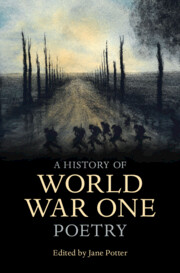23 results
Chapter 29 - Wilfred Owen (1893–1918)
- from Part III - Poets
-
-
- Book:
- A History of World War One Poetry
- Published online:
- 18 January 2023
- Print publication:
- 12 January 2023, pp 473-487
-
- Chapter
- Export citation
Acknowledgements
-
- Book:
- A History of World War One Poetry
- Published online:
- 18 January 2023
- Print publication:
- 12 January 2023, pp xx-xxii
-
- Chapter
- Export citation
Part I - Literary Contexts
-
- Book:
- A History of World War One Poetry
- Published online:
- 18 January 2023
- Print publication:
- 12 January 2023, pp 17-96
-
- Chapter
- Export citation
Index
-
- Book:
- A History of World War One Poetry
- Published online:
- 18 January 2023
- Print publication:
- 12 January 2023, pp 545-562
-
- Chapter
- Export citation
Copyright page
-
- Book:
- A History of World War One Poetry
- Published online:
- 18 January 2023
- Print publication:
- 12 January 2023, pp iv-iv
-
- Chapter
- Export citation
Part III - Poets
-
- Book:
- A History of World War One Poetry
- Published online:
- 18 January 2023
- Print publication:
- 12 January 2023, pp 329-504
-
- Chapter
- Export citation
Part II - Nations and Voices
-
- Book:
- A History of World War One Poetry
- Published online:
- 18 January 2023
- Print publication:
- 12 January 2023, pp 97-328
-
- Chapter
- Export citation
Contributors
-
- Book:
- A History of World War One Poetry
- Published online:
- 18 January 2023
- Print publication:
- 12 January 2023, pp xi-xix
-
- Chapter
- Export citation
Part IV
-
- Book:
- A History of World War One Poetry
- Published online:
- 18 January 2023
- Print publication:
- 12 January 2023, pp 505-510
-
- Chapter
- Export citation
Contents
-
- Book:
- A History of World War One Poetry
- Published online:
- 18 January 2023
- Print publication:
- 12 January 2023, pp vii-ix
-
- Chapter
- Export citation
Introduction
-
-
- Book:
- A History of World War One Poetry
- Published online:
- 18 January 2023
- Print publication:
- 12 January 2023, pp 1-16
-
- Chapter
- Export citation
Dedication
-
- Book:
- A History of World War One Poetry
- Published online:
- 18 January 2023
- Print publication:
- 12 January 2023, pp v-vi
-
- Chapter
- Export citation
Bibliography
-
- Book:
- A History of World War One Poetry
- Published online:
- 18 January 2023
- Print publication:
- 12 January 2023, pp 511-544
-
- Chapter
- Export citation

A History of World War One Poetry
-
- Published online:
- 18 January 2023
- Print publication:
- 12 January 2023
Illustrations
-
- Book:
- A History of World War One Poetry
- Published online:
- 18 January 2023
- Print publication:
- 12 January 2023, pp x-x
-
- Chapter
- Export citation
Coda: Legacies of World War One Poetry
- from Part IV
-
-
- Book:
- A History of World War One Poetry
- Published online:
- 18 January 2023
- Print publication:
- 12 January 2023, pp 507-510
-
- Chapter
- Export citation
A state-wide audit of unhealthy sponsorship within junior sporting clubs in Victoria, Australia
-
- Journal:
- Public Health Nutrition / Volume 24 / Issue 12 / August 2021
- Published online by Cambridge University Press:
- 26 May 2021, pp. 3797-3804
-
- Article
-
- You have access
- HTML
- Export citation
Central venous catheter bundle adherence: Kamishibai card (K-card) rounding for central-line–associated bloodstream infection (CLABSI) prevention
-
- Journal:
- Infection Control & Hospital Epidemiology / Volume 41 / Issue 9 / September 2020
- Published online by Cambridge University Press:
- 04 June 2020, pp. 1058-1063
- Print publication:
- September 2020
-
- Article
- Export citation
Health Care for Mitochondrial Disorders in Canada: A Survey of Physicians
-
- Journal:
- Canadian Journal of Neurological Sciences / Volume 46 / Issue 6 / November 2019
- Published online by Cambridge University Press:
- 07 August 2019, pp. 717-726
-
- Article
-
- You have access
- HTML
- Export citation
23 - The book in wartime
- from Part IV
-
-
- Book:
- The Cambridge History of the Book in Britain
- Published online:
- 08 June 2019
- Print publication:
- 13 June 2019, pp 567-579
-
- Chapter
- Export citation



